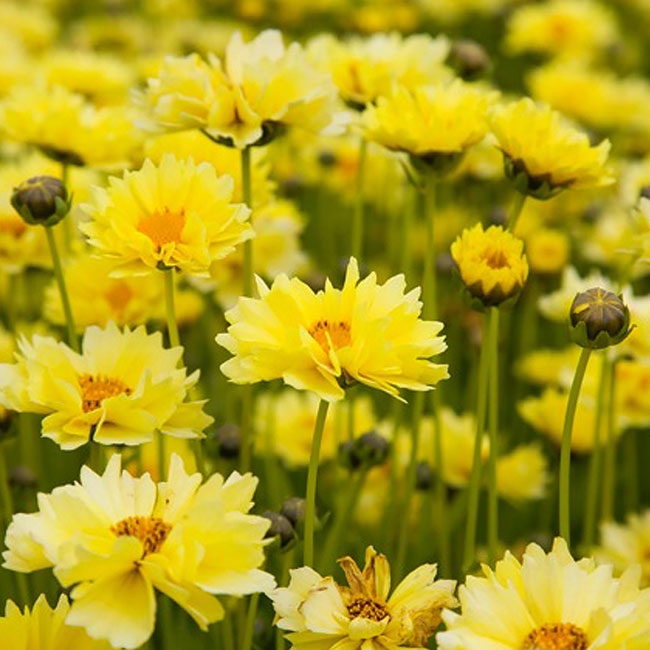
Features
Crop Culture
Inputs
COREOPSIS Crop Culture Tips
While long flowering has long been a coreopsis key trait, today’s introductions take that to new levels, holding blooms long after other perennials fade. This longtime consumer favourite still has some surprises to share.
August 8, 2017 By Josiah Raymer
 Solar Dance
Solar Dance August 2017 – A wildflower long tamed, growers and gardeners alike love coreopsis for its low maintenance and long life, but this staple still has a few surprises to share.
Many newer varieties of this North American native have been selected for extended bloom time and mildew resistance. While long flowering has long been a coreopsis key trait, today’s introductions take that to new levels, holding blooms long after other perennials fade.
A few of our new favourites include the Big Bang™ (61 cm/up to 24″), Lil Bang™ (31 cm/under 12″) and Satin & Lace™ series (colourful patterns to spare). Some of our favourite single selections include Solar Dance for its double and semi-double lemon yellow flowers and Sunkiss, with a touch of deep red at the base.
Most varieties are hardy in Zones 4 or 5 to 9. Excellent heat and drought tolerance lets them transition easily from more moderate to triple digit temperatures (Fahrenheit). The huge colour range of the coreopsis family makes it extremely versatile, and a great choice for spring and summer combos and gardens as well as early fall containers.
Coreopsis are produced in a 72 cell tray with a 6 cm (2.35”) soil depth, maximum dry volume 3.65 cubic metres (2.23 cubic inches). Transplant one plant per each trade gallon pot into a media with good drainage. Plants will be ready for spring sales in approximately six to eight weeks.
Recommended Finish Size: Coreopsis produce best in a standard one gallon pot.
Growing media: Choose a disease-free, well-draining commercial soilless media.
Growing temperature: Provide daytime greenhouse temperatures of 18 to 24 C (65 to 75 F) and nighttime temperatures of 13 to 18 C (55 to 65 F).
Light requirements: Coreopsis prefers high light levels of at least 5000 foot-candles or full sun.
Supplemental lighting: Coreopsis plants require a minimum of 14 hours photoperiod.
Soil pH: Maintain soil pH at approximately 5.8 to 6.2.
Soil electrical conductivity (EC): Soil electrical conductivity (EC) should be maintained at approximately 1.8 to 2.2 mS/cm using the 2:1 extraction method.
Pinching and plant growth regulators (PGRs): Coreopsis typically doesn’t require pinching or PGRs.
Fertilization: Provide a constant, well-balanced liquid feed with low levels, approximately 100 to 150 ppm, of nitrogen.
Moisture level: Grow plants evenly moist.
Pests and diseases: Follow standard sanitation practices and monitor and scout carefully to prevent any insect and disease activity. In particular, watch for aphids, thrips, botrytis and powdery mildew. In most areas, though, they should not be a problem with the proper protocols in place.
Ensure a good preventive program is in place, including managing humidity levels and maintaining good air circulation.
Apply a broad spectrum fungicide drench at liner planting. You may also follow a monthly broad spectrum fungicide control program.
Vernalization requirements: Vernalization is beneficial, but not completely necessary.
Daylength: Coreopsis is a long day plant.
Josiah Raymer is head grower and general manager for Emerald Coast Growers, one of North America’s largest ornamental grass producers. For further information visit www.ecgrowers.com.
Print this page

